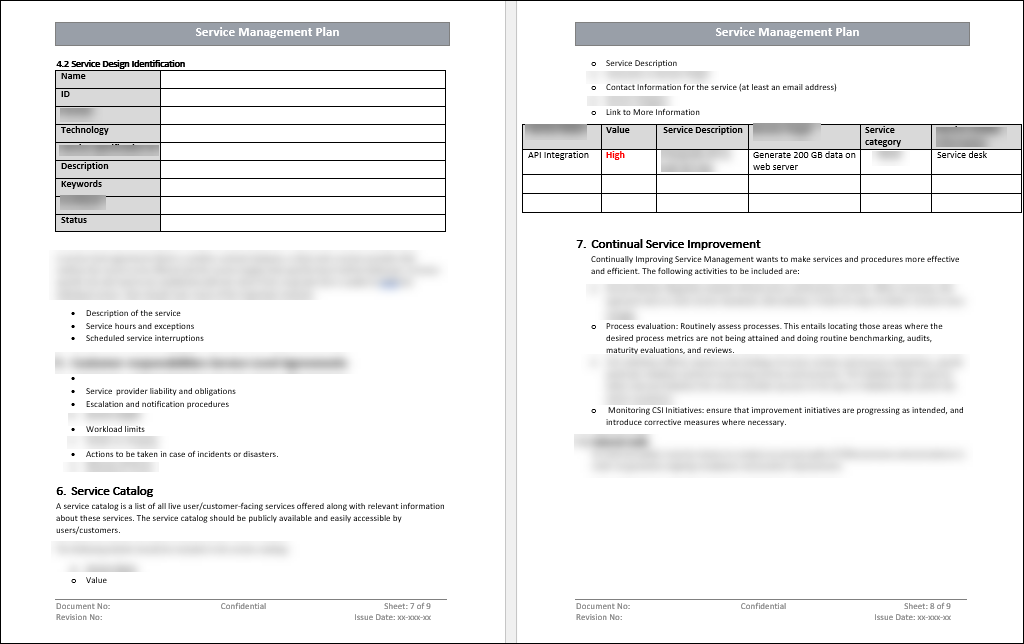Service Management Plan Template
Introduction
A Service Management Plan (SMP) Template in IT Governance is a fundamental document that defines the strategic framework and operational elements for managing IT services inside an organisation. It outlines the scope, objectives, and major components of service delivery, which include service design, transfer, operation, and continuous improvement. The SMP template outlines roles and responsibilities, service levels, and KPIs, providing a road map for aligning IT services with business objectives. The template improves productivity, minimises risks, and allows for continuing optimisation of IT operations, all of which contribute to the overall efficacy of an organization's IT governance framework.

Scope Of Service Management Plan Template
The Service Management Plan (SMP) template is critical in the field of IT Governance, acting as a blueprint for organisations to strategically and effectively manage their IT services. This template serves as a thorough reference, outlining the scope, objectives, and procedures for delivering IT services that are aligned with the overall company strategy. It describes the full service lifecycle, from design and transition to operation and continuous improvement, offering a systematic way to ensuring consistency and dependability in service delivery.
Components Of A Service Management Plan Template
1. Service Strategy: Service plan is the phase of IT Service Management that focuses on creating the overall plan for delivering IT services in accordance with business objectives and customer requirements.
2. Service Strategy Plan And Business Case: The Service Strategy Plan and Business Case are essential components of the SMP, since they provide a thorough roadmap for implementing the service strategy.
3. Strategic Initiatives: Strategic initiatives are large projects or programmes identified in the service strategy to achieve certain business goals.
4. Service Design Activities: These include the planning and design activities required for the successful implementation of IT services.
5. Service Level Agreement (SLA): A Service Level Agreement is a legal contract that specifies the agreed-upon levels of service between the service provider and the client.
6. Customer Responsibilities In Service Level Agreements: This component of SLAs describes the precise duties that customers bear in assuring the successful delivery and performance of IT services.
7. Service Catalog: It provides detailed information about each service, including descriptions, dependencies, and service levels, serving as a crucial reference for both service providers and customers.
8. Continual Service Improvement: Continual Service Improvement is an ongoing process in IT service management aimed at identifying and implementing improvements in service delivery, processes, and performance.

Benefits Of Service Management Plan Template
- Strategic Alignment: Aligning IT services with business goals improves the organization's capacity to accomplish strategic objectives, resulting in a more coherent and integrated approach.
- Improved Operational Efficiency: Improved operational efficiency results in faster incident resolution, less downtime, and better overall performance of IT services.
- Risk Management: Risk management involves proactively identifying and managing risks to prevent service disruptions and ensure a more stable and reliable IT environment.
- Enhanced Customer Satisfaction: Meeting or exceeding service expectations increases customer satisfaction, which fosters positive relationships between IT and its users.
- Cost Optimization: Organisations can optimise their budget by properly controlling costs and allocating resources to support IT services.
- Continuous Improvement Culture: Establishing a culture of continuous improvement ensures that IT services grow in response to changing business needs, keeping the organisation agile and adaptable.
Conclusion
The Service Management Plan (SMP) template is a critical component in the effective governance and delivery of IT services inside an organisation. The SMP template acts as a guide document, aligning IT services with broader business objectives, by offering a structured framework that includes service strategy, design, operation, and continuous improvement. The SMP template's various components, such as strategic objectives, service level agreements, and continuous service improvement plans, work together to ensure the smooth operation of IT services and increase organisational efficiency.

